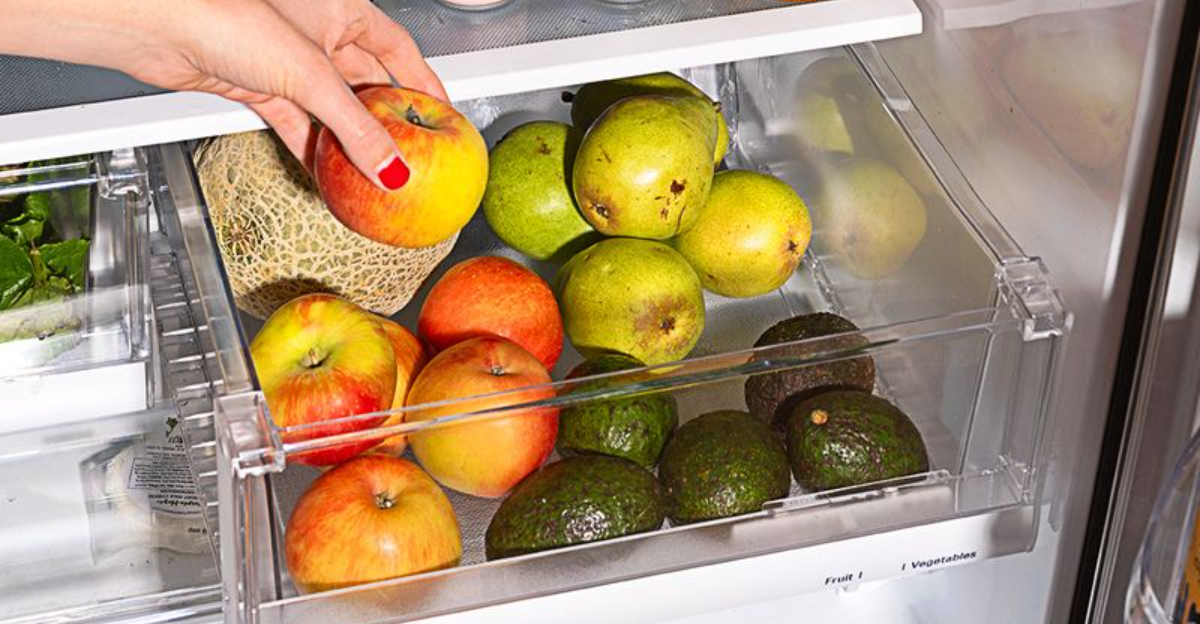20 Clever Tips To Help You Keep Food Fresh Longer

There’s nothing worse than opening the fridge to find your favorite snacks turning into sad, wilted versions of themselves.
Keeping food fresh longer doesn’t have to be a mystery or a chore. With a few smart tricks, you can extend the life of fruits, veggies, and leftovers without losing flavor or texture.
These clever tips are like secret weapons against waste, making your groceries last and your meals stay delicious for days.
1. Paper Towel Magic for Leafy Greens
Nothing ruins a salad plan faster than slimy spinach! Line airtight containers with paper towels before adding your lettuce, kale, or other leafy greens.
The paper absorbs excess moisture that causes wilting and decay.
Replace the paper towel when it becomes damp. This simple trick can extend freshness from a few days to nearly two weeks. Your salads will thank you!
2. Aluminum Foil Wrap for Celery
Forget plastic bags for celery storage! Aluminum foil creates the perfect environment by allowing ethylene gas to escape while keeping moisture locked in.
Simply wrap your celery stalks tightly in foil before refrigerating. Your celery will stay crisp and fresh for weeks instead of days.
No more finding sad, limp celery hiding in your vegetable drawer when you need it for soup or snacking!
3. Single-Layer Storage for Strawberries
Strawberries spoil quickly when stacked on top of each other. The weight crushes berries on the bottom, creating perfect conditions for mold growth.
Instead, arrange them in a single layer on a paper-towel-lined tray in your refrigerator.
Don’t wash berries until you’re ready to eat them! Water speeds up decay. This method keeps strawberries fresh and mold-free for up to a week longer than traditional storage.
4. Upside-Down Tomato Storage
Tomatoes hate the cold! Keep them at room temperature with their stem side facing down on your counter. This prevents air from entering through the stem scar, slowing ripening and decay.
Never refrigerate uncut tomatoes – it destroys their flavor and texture.
Once cut, store leftovers in the fridge in an airtight container. This simple flip extends freshness while preserving that perfect tomato taste.
5. Herb Ice Cubes
Fresh herbs going bad before you can use them? Chop them finely, place in ice cube trays, and cover with olive oil before freezing.
These flavor bombs are perfect for instantly seasoning soups, sauces, and sautés. Different herbs work better with different oils – basil with olive oil, cilantro with vegetable oil.
Label each tray with herb types and freezing dates. Pop out cubes as needed for up to six months of fresh herb flavor!
6. Paper Bag Technique for Mushrooms
Mushrooms suffocate in plastic! Their high moisture content causes them to get slimy when trapped in plastic bags or containers.
Instead, store them in paper bags in your refrigerator’s crisper drawer. The paper absorbs excess moisture while allowing enough airflow to keep fungi fresh.
Never wash mushrooms until right before cooking. Simply brush off any dirt with a soft brush or paper towel to maintain their earthy goodness longer.
7. Onion-Paired Avocados
Half-eaten avocados turn brown faster than you can say guacamole! Place avocado halves (with the pit still in) in a sealed container with a few slices of red onion.
The compounds in onions prevent oxidation that causes browning. Don’t worry – the avocado won’t absorb the onion flavor.
This trick keeps your avocado green and fresh for days. Just remove the onion pieces before using your perfectly preserved avocado half!
8. Vacuum Wine Preservation
Opened wine loses its magic quickly when exposed to air. Invest in a vacuum wine stopper to suck out oxygen before resealing.
This simple tool preserves opened bottles for up to a week longer than regular stoppers. Different wines have different shelf lives even with vacuum sealing.
Whites and rosés last 3-5 days, while reds can go 3-6 days depending on their tannin content. Store all opened wine in the refrigerator, even reds (just let them warm up before serving).
9. Parchment Paper Cheese Storage
Cheese needs to breathe! Plastic wrap suffocates cheese, encouraging mold growth and off-flavors.
Wrap cheese in parchment paper instead, then place in a partially sealed plastic bag or container for humidity control.
The parchment creates the perfect balance of airflow and moisture retention.
Different cheese varieties have different storage needs, but most benefit from this method. Change the parchment whenever it becomes damp for maximum freshness.
10. Salt Water Soak for Apples
Crisp apples stay fresher longer with a quick salt water bath! Mix one tablespoon of salt into a gallon of cold water and soak apples for 5-10 minutes.
The salt destroys bacteria and mold spores on the surface. Rinse thoroughly and dry completely before refrigerating.
This natural treatment extends apple freshness by 1-2 weeks. The salt doesn’t affect the taste but makes a huge difference in storage life. Perfect for apple lovers who buy in bulk!
11. Banana Isolation Strategy
Bananas are the social influencers of your fruit bowl – they release ethylene gas that speeds ripening of nearby fruits!
Keep them separated from other produce to prevent premature ripening of everything else. Hang bananas on a dedicated hook instead of piling them in a bowl.
Once they reach your preferred ripeness, refrigerate them. The peel will darken, but the fruit inside will stay fresh for days longer than at room temperature.
12. Wax Paper Bread Freezing
Freezer-burned bread is so disappointing! Prevent this by placing wax paper between slices before freezing in an airtight bag.
The paper creates barriers that make it easy to separate just the slices you need without thawing the entire loaf. Squeeze out as much air as possible before sealing the bag.
Bread stored this way stays fresh-tasting for up to three months. Toast frozen slices directly from the freezer for the freshest taste with minimal waste!
13. Airtight Rice Storage
Rice absorbs odors and moisture like a sponge! Transfer store-bought rice to airtight containers with moisture-absorbing packets inside.
Mason jars, plastic containers with tight seals, or purpose-made rice dispensers all work wonderfully. Label containers with purchase dates.
White rice stays good for up to two years when stored properly, while brown rice lasts about six months before its natural oils turn rancid.
The right container makes all the difference between fresh rice and stale, buggy disappointment!
14. Citrus Crisper Drawer Technique
Oranges, lemons, and limes last twice as long when stored properly! Place them unwashed in the crisper drawer of your refrigerator, which provides the perfect humidity level to prevent drying out and molding.
Adjust the drawer’s humidity setting to medium. Check regularly for any soft spots and remove affected fruit immediately.
Room temperature citrus looks pretty in a bowl but lasts only days, while refrigerated fruit stays juicy for weeks.
15. Silica Gel Packets for Dried Goods
Don’t throw away those little silica gel packets that come in shoe boxes and electronics! They’re perfect for keeping dried foods fresh.
Place them in containers with crackers, dried fruits, or spices to absorb moisture that causes staleness. Replace the packets every few months for continued effectiveness.
You can even buy food-grade silica packets specifically for pantry use. This simple hack keeps your favorite snacks crunchy and dried herbs flavorful for months longer.
16. Garlic Cloves Preserved in Oil
Peeled garlic cloves dry out quickly in the fridge. Extend their life by submerging peeled cloves in olive oil in a sealed jar.
The oil prevents air exposure while infusing with delicious garlic flavor – a two-for-one kitchen win! Store this jar in the refrigerator, not at room temperature.
The garlic-infused oil is perfect for cooking and the cloves stay fresh for up to three weeks. Use a clean fork to remove cloves as needed to prevent contamination.
17. Mesh Bag Onion Storage
Onions need good air circulation to stay fresh! Store them in mesh bags hanging in a cool, dark place like a pantry or cellar.
The mesh allows air movement that prevents moisture buildup and sprouting. Never store onions in plastic bags or near potatoes.
The gases they emit interact and cause both to spoil faster. Properly stored onions can last up to three months. Keep them in a dark spot since light encourages sprouting.
18. Upside-Down Yogurt Technique
Flip that yogurt container! Storing yogurt cups upside-down creates a vacuum effect that inhibits mold growth on the surface.
This works especially well for Greek yogurt and other varieties without fruit on the bottom.
Make sure the lid is sealed tightly before inverting. This simple flip can extend yogurt freshness by several days past the expiration date.
Check for any signs of spoilage before eating, but you’ll likely notice much less watery separation and no mold.
19. Original Carton Egg Storage
Those built-in refrigerator egg holders look convenient but actually reduce freshness! Keep eggs in their original carton on a middle shelf rather than in the door.
The carton provides protection from odors and temperature fluctuations.
Door storage exposes eggs to warm air every time you open the fridge. The cardboard carton maintains consistent temperature and humidity.
Properly stored eggs stay fresh for 3-5 weeks, compared to just 1-2 weeks when improperly stored.
20. Coffee Bean Freezing Method
Coffee lovers, listen up! Freeze excess beans in airtight bags with all air removed to preserve that fresh-roasted flavor. Divide beans into weekly portions so you only thaw what you’ll use soon.
Press out all air before sealing bags to prevent freezer burn. Never return thawed beans to the freezer as this creates moisture that ruins flavor.
Properly frozen coffee stays fresh for up to three months instead of going stale after just two weeks at room temperature.
